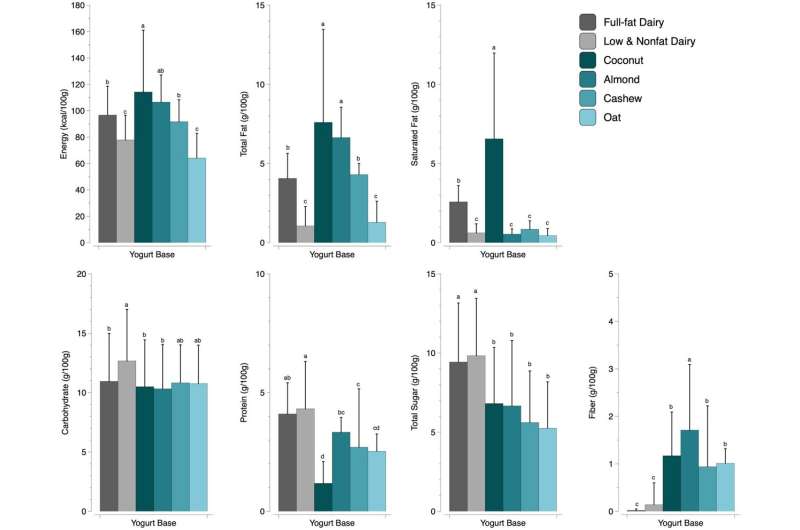Thats not nuts: Almond milk yogurt packs an overall greater nutritional punch than dairy-based milk

In a nutritional comparison of plant-based and dairy yogurts, almond milk yogurt came out on top, according to research led by a University of Massachusetts Amherst food science major.
“Plant-based yogurts overall have less total sugar, less sodium and more fiber than dairy, but they have less protein, calcium and potassium than dairy yogurt,” says lead author Astrid D’Andrea, a graduating senior whose paper was published May 25 in a special issue of the journal Frontiers in Nutrition titled “Food of the Future: Meat and Dairy Alternatives.”
“But when looking at the overall nutrient density, comparing dairy yogurt to plant-based yogurt, with the nutrients that we looked at, almond yogurt has a significantly higher nutrient density than dairy yogurt and all other plant-based yogurts.”
Working in the lab of senior author Alissa Nolden, a sensory scientist and assistant professor of food science, D’Andrea was interested in comparing the nutritional values of plant-based and dairy yogurts, an area of research she found lacking. Driven by concerns over environmental sustainability and eating less animal-based food products, the plant-based yogurt market is expected to explode from $1.6 billion in 2021 to $6.5 billion in 2030.
“Plant-based diets are gaining popularity, especially in American culture, but just because it’s plant-based doesn’t mean it’s moreAlissa_Nolden 1.jpg nutritious,” says D’Andrea, of Hazlet, N.J., who is heading to graduate school in food science at Penn State. “There has to be specific research that answers that question.”
D’Andrea collected nutritional information for 612 yogurts, launched between 2016 and 2021, using the Mintel Global New Products Database, accessed through UMass Libraries. She used the Nutrient Rich Foods (NRF) Index, which assigns scores based on the nutrient density of foods. “This allowed us to compare the nutritional density of the yogurts based on nutrients to encourage (protein, fiber, calcium, iron, potassium, vitamin D) and nutrients to limit (saturated fat, total sugar, sodium),” D’Andrea writes in her paper.
The researchers chose the NRF model based on the nutritional benefits of dairy yogurt, which provides a complete protein, something plant-based products are unable to do.
Of the 612 yogurts analyzed, 159 were full-fat dairy, 303 were low- and nonfat dairy, 61 were coconut, 44 were almond, 30 were cashew and 15 were oat. The researchers used the NRF Index to rank the yogurts from the highest to lowest nutrient density: almond, oat, low- and nonfat dairy, full-fat dairy, cashew and coconut.
D’Andrea attributed the high scores of almond and oat yogurts to their low levels of total sugar, sodium and saturated fat. She and Nolden say the study’s findings can inform the food industry on ways to improve the formulation and nutritional composition of plant-based yogurts.
One option the researchers offer is creating a hybrid yogurt that is both plant- and dairy-based. This will add protein, vitamin B12 and calcium while still minimizing total sugar, sodium and saturated fat.
“Going from dairy all the way to plant-based is a big change,” Nolden says. “There are changes in the nutritional profile, and there’s change in the sensory profile, which might prevent consumers from trying it.”
In fact, a recent study conducted in the Nolden lab led by former UMass Amherst visiting researcher Maija Greis investigated consumer acceptance of blended plant-based and dairy yogurt and found that people preferred the blended yogurt over the plant-based one.
“Blending provides advantages,” Nolden says. “It provides a complete protein, and the dairy part helps to form the gelling structure within the yogurt that so far we are unable to replicate in a plant-based system.”
The UMass Amherst team says further research is warranted, based on their findings that suggest a way to maximize the nutrition and functional characteristics of yogurt.
“If we can blend plant-based and dairy yogurt, we can achieve a desirable sensory profile, a potentially better nutritional profile and have a smaller impact on the environment,” Nolden says.
More information:
Astrid E. D’Andrea et al, A comparison of the nutritional profile and nutrient density of commercially available plant-based and dairy yogurts in the United States, Frontiers in Nutrition (2023). DOI: 10.3389/fnut.2023.1195045
Journal information:
Frontiers in Nutrition
Source: Read Full Article
